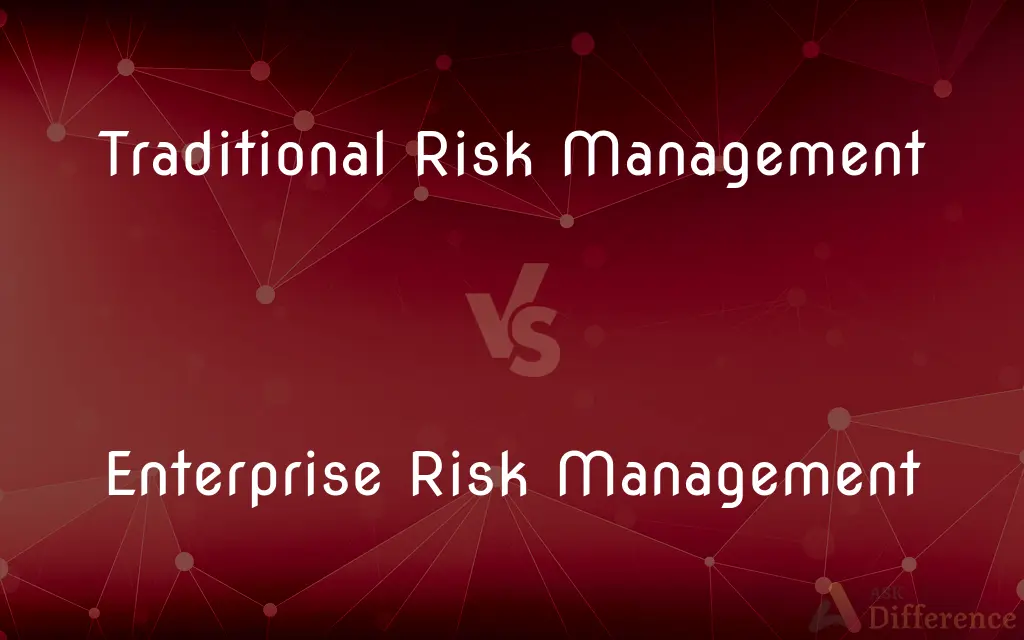Traditional Risk Management vs. Enterprise Risk Management — What's the Difference?
By Urooj Arif & Maham Liaqat — Published on November 9, 2024
Traditional Risk Management focuses on identifying and mitigating financial and hazard risks, often in silos. Enterprise Risk Management adopts a holistic approach, integrating all types of risk across an organization to inform strategic decision-making.

Difference Between Traditional Risk Management and Enterprise Risk Management
Table of Contents
ADVERTISEMENT
Key Differences
Traditional Risk Management (TRM) primarily concentrates on safeguarding assets and financial health against risks such as legal liabilities, natural disasters, and accidents. It operates within specific departments or functions, addressing risks in isolation. Enterprise Risk Management (ERM), however, encompasses a broader spectrum, including strategic, operational, financial, and compliance risks. It aims to identify, assess, manage, and monitor risks organization-wide under a unified framework.
TRM often reacts to risks as they occur, focusing on mitigation and transfer strategies (like insurance), whereas ERM is proactive, seeking to predict and manage risks before they impact the organization. ERM integrates risk management into the company's strategic planning, ensuring that risks are considered in decision-making processes and business strategies.
ERM’s holistic approach facilitates better resource allocation, enhancing the organization's ability to achieve its objectives, whereas TRM tends to be more compartmentalized, potentially leading to inefficiencies or overlooked risks that could affect other parts of the organization.
ERM encourages a risk-aware culture throughout the organization, involving employees at all levels in identifying and managing risks. This contrasts with TRM, where risk management responsibilities are typically confined to specialized departments or roles, such as risk managers or insurance buyers.
The adoption of ERM enables organizations to balance risk and reward, aligning risk appetite with strategic goals. TRM, being more narrowly focused, might not directly contribute to strategic objectives, primarily aiming to protect the organization from losses rather than leveraging risk for strategic advantage.
ADVERTISEMENT
Comparison Chart
Focus
Financial and hazard risks
All types of risk (strategic, operational, etc.)
Approach
Reactive, siloed
Proactive, integrated
Objective
Protect assets and financial health
Inform strategic decision-making, balance risk-reward
Scope
Specific departments/functions
Organization-wide
Strategy
Mitigation and transfer
Identification, assessment, management, monitoring
Involvement
Specialized departments/roles
All levels of the organization
Contribution to Strategic Goals
Limited, mainly protective
Direct, by aligning risk appetite with strategy
Compare with Definitions
Traditional Risk Management
TRM's goal is to protect the company's existing assets.
The risk manager updated the asset protection plan to include cyber threats.
Enterprise Risk Management
Strategic risks, like market changes, are central to ERM.
The ERM framework was updated to reflect risks from new regulatory changes.
Traditional Risk Management
TRM strategies include creating safety protocols.
Implementing stricter safety measures reduced workplace accidents last quarter.
Enterprise Risk Management
ERM aims to leverage risk for competitive advantage.
Analyzing risks associated with an expansion allowed the company to enter a new market confidently.
Traditional Risk Management
It often involves purchasing insurance as a key strategy.
After assessing flood risks, the firm decided to buy additional property insurance.
Enterprise Risk Management
ERM fosters a risk-aware culture among all employees.
Staff training sessions were held to encourage proactive risk identification.
Traditional Risk Management
TRM focuses on minimizing financial losses.
The company increased its insurance coverage to mitigate potential lawsuit damages.
Enterprise Risk Management
It involves a continuous process of risk assessment.
Quarterly risk reviews ensure that emerging threats are promptly addressed.
Traditional Risk Management
Risk assessments in TRM typically look at past incidents.
Historical data on thefts informed the new security system upgrades.
Enterprise Risk Management
ERM integrates risk management with strategic planning.
The ERM team worked with executives to align new investments with the company's risk appetite.
Common Curiosities
Can TRM and ERM coexist in an organization?
Yes, TRM can be a component of ERM, focusing on specific risks, while ERM integrates these efforts into a broader, strategic framework.
What is Enterprise Risk Management?
ERM is a comprehensive approach that integrates risk management across an organization, considering all types of risks to inform strategic decisions.
Is ERM more effective than TRM?
ERM is considered more effective for strategic planning and decision-making as it provides a holistic view of risks organization-wide.
How does ERM contribute to strategic goals?
ERM aligns risk management with strategic objectives, helping organizations balance risk and reward in pursuit of their goals.
How do TRM and ERM differ in focus?
TRM focuses on financial and hazard risks, while ERM encompasses all risk types, including strategic and operational.
What strategies are common in TRM?
TRM commonly employs mitigation and insurance strategies to protect against financial and physical losses.
What role do employees play in ERM?
In ERM, employees at all levels are involved in identifying and managing risks, fostering a culture of risk awareness.
Is ERM applicable to all types of organizations?
Yes, ERM can be adapted to any organization, regardless of size or industry, to manage risks effectively.
What is a key benefit of implementing ERM?
A key benefit of ERM is its ability to improve decision-making and strategic planning by providing a comprehensive view of risks.
What is Traditional Risk Management?
TRM focuses on protecting an organization's assets and financial health by addressing financial and hazard risks in isolation.
Why is ERM considered proactive?
ERM is proactive because it anticipates and manages risks before they occur, integrating risk management into strategic planning.
How does ERM affect organizational culture?
ERM promotes a risk-aware culture, encouraging proactive risk management and strategic thinking among all employees.
How does ERM identify risks?
ERM uses continuous assessment and monitoring to identify both internal and external risks across the organization.
Can TRM address strategic risks?
While TRM primarily focuses on financial and hazard risks, strategic risks are typically outside its scope, being a core focus of ERM.
Why is continuous monitoring important in ERM?
Continuous monitoring in ERM ensures that emerging risks are identified and addressed promptly, keeping the organization's risk profile up to date.
Share Your Discovery

Previous Comparison
Thus Far vs. So Far
Next Comparison
Memory vs. Hard DiskAuthor Spotlight
Written by
Urooj ArifUrooj is a skilled content writer at Ask Difference, known for her exceptional ability to simplify complex topics into engaging and informative content. With a passion for research and a flair for clear, concise writing, she consistently delivers articles that resonate with our diverse audience.
Co-written by
Maham Liaqat









































